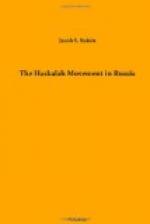Yes, the Jews began to pay, if they had ever been in debt, for the good that had for a while been bestowed upon them by Alexander I. Alexander Nebakhovich was a well-known theatrical director, his brother Michael was the editor of the first Russian comic paper Yeralash, and Osip Rabinovich showed marked ability in serious journalism. In 1842 died Abraham Jacob Stern, the greatest inventor Russia had till then produced; and, as if to corroborate the statement of the Talmud, that when one sun sets another rises, the Demidoff prize of two thousand five hundred rubles was the same year awarded to his son-in-law, Hayyim Selig Slonimsky (HaZas, 1810-1904) of Byelostok, for the first of his valuable inventions. Stern’s genius was surpassed, though in a different direction, only by that of Elijah Vilna. His first invention was a calculating machine, which led to his election as a member of the Warsaw Society of the Friends of Science (1817) and to his being received twice by Alexander I (1816, 1818), who bestowed upon him an annual pension of three hundred and fifty rubles. This invention was followed by another, “a topographical wagon for the measurement of level surfaces, an invention of great benefit to both civil and military engineers.” He also constructed an improved threshing and harvesting machine and a sickle of immense value to agriculture.[32]
But it is scarcely possible, nor would it be profitable, to enumerate either the places or the persons who were, so to speak, inoculated with the Haskalah virus. In Grodno, Kovno, Lodz, Minsk, Mohilev, Pinsk, Zamoscz, Slutsk, Vitebsk, Zhagory, and other places, they were toiling zealously and diligently, these anchorites in the desert of knowledge. Among them were men of all classes and callings, from the cloistered Talmudist to the worldly merchant. The path of Haskalah was slowly yet surely cleared. The efforts of the conservative Maskilim were not devoid of some good results, nor even were those of Nicholas, though aimed at Christianizing rather than civilizing, entirely wasted. With all their shortcomings, and though producing but few rabbis acceptable to Russo-Jewish congregations, the seminaries in Warsaw, Zhitomir, and Vilna were powers for enlightenment. In them the future prominent scientists, scholars, and litterateurs were reared, and there the foundations were laid for the activities of Goldfaden, Gurland, Harkavy, Kantor, Landau, Levanda, Mandelkern, Paperna, Pumpyansky, Rosenberg, Steinberg, and others. Their fate was that of Mendelssohn’s Bible translation. The end became a means, the means, an end. But they not only “brought forth” great men, they rendered no less important a service in “bringing out” those already great. Had it not been for their professorships, men like Abramovitsch, Lerner, Plungian, Slonimsky, Suchastover, and Zweifel, who were not blessed with worldly goods like Fuenn, Katzenellenbogen, Luria, or Strashun, would probably have sought in private teaching or petty trading a source of subsistence, and Judaism in general and Russian Jewry in particular would have sustained a considerable loss. They helped to prepare the soil, even to implant the germ, and




